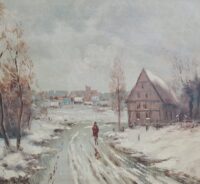Born in Pleß, Upper Silesia, he spent his childhood in Breslau after the early death of his father in 1876, where he attended the Matthias-Gymnasium and began training with the decorative painter Georg Heintze in 1886. He later continued his education at the School of Arts and Crafts in Breslau and was taught by teachers such as Heinrich Irmann, Paul Schobelt and Albrecht Bräuer.
In 1894, Münzer began his studies at the Academy of Fine Arts in Munich, where he was taught by renowned artists such as Karl Raupp and Otto Seitz. During his military service, he joined the painting class of Paul Hoecker, who was intensively involved in open-air painting. Münzer was even given his own master studio here in 1896.
In 1898, he was one of two prize winners in Ludwig Stollwerck’s first competition for designs for Stollwerck collector’s pictures, with prize money of 1000 marks. From 1899, Münzer exhibited his works in the Munich Glaspalast as a member of the Scholle artists’ group. This also led to his collaboration with the Munich weekly magazine “Jugend” and the satirical magazine “Simplicissimus.”
During a stay in Paris from 1900 to 1902, he consolidated his artistic development. In 1903, he met Marie Therese Dreeßen, née von Vestenhof, whom he married a year after a spectacular scandal. This scandal led to the divorce of Mrs. Dreeßen and her husband.
In 1909, Münzer became head of a painting class at the Düsseldorf Art Academy, where he taught until 1932. During this time, he also created murals and ceiling paintings for the Düsseldorf district government. During the First World War, he served as a war painter at the front in 1915 and volunteered in 1917, but did not see action.
In 1938, the Münzer family moved to Holzhausen am Ammersee. Münzer’s works were exhibited in various renowned museums and collections, including the Neue Pinakothek in Munich, the Wallraf-Richartz-Museum in Cologne, the Städtisches Kunstmuseum Düsseldorf and the collection of the Kunstverein Basel.
Between 1938 and 1944, Münzer actively participated in the Great German Art Exhibitions initiated by the National Socialists in Munich’s House of German Art and even sold a work to Adolf Hitler. In 1950, he exhibited thirty paintings at the Munich Artists’ Cooperative. In 1944, Münzer was included in the list of those pardoned by the Reich Ministry for Popular Enlightenment and Propaganda.
Münzer’s narrative style was evident in his graphics, particularly in his fairy tale illustrations for the Scholz publishing house in Mainz. He was also a member of the Deutscher Künstlerbund.



